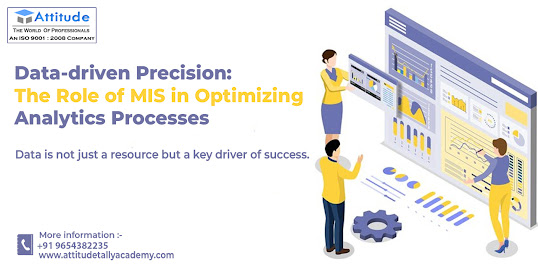Data-driven Precision: The Role of MIS in Optimizing Analytics Processes
Introduction
In today's dynamic business
environment, the incessant surge of data has propelled organizations to
redefine their strategies and embrace the transformative power of information.
Amidst this data-centric landscape, the interplay between "Data-driven
Precision" and "Data-driven
Decision-Making" emerges as a crucial dynamic. This blog delves into
the profound significance of these concepts and elucidates how Management
Information Systems (MIS) serve as the linchpin, optimizing analytics processes
for strategic advantage.
Unraveling Data-driven
Precision
At the core of analytics
lies the concept of data-driven precision – a strategic maneuver that
transcends mere data accumulation. Precision, in this context, transcends the
sheer volume of data, emphasizing the extraction of meaningful insights that
propel astute business strategies. Organizations increasingly recognize the
pivotal role of precision in decision-making, recognizing its potential to
foster more effective and targeted actions.
MIS: Orchestrating
Precision Analytics
The orchestration of
data-driven precision owes much to the indispensable role played by Management
Information Systems (MIS). Acting as the backbone of an organization's
information infrastructure, MIS facilitates the seamless collection,
processing, and analysis of data. Robust MIS implementations ensure that
organizations have access to the right data at the right time and in the right
format, thereby enabling precision in decision-making processes.
Building the Foundation:
Data Integration
Data integration serves as
the foundational bedrock upon which data-driven decision-making stands. This
intricate process involves the harmonious unification of data from diverse
sources to create a comprehensive view. The essence of seamless data integration
lies in dismantling data silos, fostering a unified data ecosystem that allows
for holistic insights.
Silo Demolition with MIS
MIS emerges as the key
catalyst in the breakdown of data silos, seamlessly connecting disparate
systems and databases. Serving as a centralized platform for data management,
MIS eliminates barriers that often impede effective decision-making. This
integration paves the way for a more comprehensive analysis of data, leading to
nuanced insights and a clearer understanding of business operations.
Data-Driven Imperative: A
Strategic Odyssey
With the establishment of
data-driven precision and seamless data integration, organizations embark on
the strategic odyssey of data-driven decision-making. This approach involves
leveraging data analytics to inform and guide business strategies, ensuring
that decisions are not just informed but deeply rooted in actionable insights.
Empowering Decision-Makers:
The MIS Advantage
MIS takes center stage in
empowering decision-makers by providing real-time access to critical
information. Through intuitive dashboards, insightful reports, and cutting-edge
analytics tools, MIS ensures that leaders can make informed decisions promptly.
The integration of data from diverse sources ensures that decisions are not
made in isolation but are grounded in a comprehensive understanding of the
business landscape.
In Conclusion
In the ever-evolving
landscape of data-driven strategies, the integration of data-driven precision
and data integration stands
as a cornerstone. The role of MIS in optimizing analytics processes emerges as
a strategic imperative. As organizations navigate the complexities of a
data-driven world, investing in robust MIS becomes not just a choice but a
necessity. By embracing precision analytics, shattering data silos through
integration, and harnessing the capabilities of MIS, organizations can not only
stay competitive but also thrive in an environment where data is not just a
resource but a key driver of success.




Comments
Post a Comment